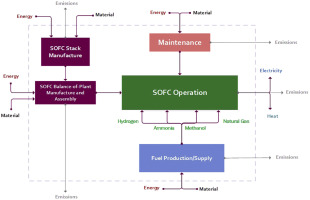International Journal of Hydrogen Energy ( IF 7.2 ) Pub Date : 2018-12-12 , DOI: 10.1016/j.ijhydene.2018.11.122 Yusuf Bicer , Farrukh Khalid

|
This study aims to provide a comprehensive environmental life cycle assessment of heat and power production through solid oxide fuel cells (SOFCs) fueled by various chemical feeds namely; natural gas, hydrogen, ammonia and methanol. The life cycle assessment (LCA) includes the complete phases from raw material extraction or chemical fuel synthesis to consumption in the electrochemical reaction as a cradle-to-grave approach. The LCA study is performed using GaBi software, where the selected impact assessment methodology is ReCiPe 1.08. The selected environmental impact categories are climate change, fossil depletion, human toxicity, water depletion, particulate matter formation, and photochemical oxidant formation. The production pathways of the feed gases are selected based on the mature technologies as well as emerging water electrolysis via wind electricity. Natural gas is extracted from the wells and processed in the processing plant to be fed to SOFC. Hydrogen is generated by steam methane reforming method using the natural gas in the plant. Methanol is also produced by steam methane reforming and methanol synthesis reaction. Ammonia is synthesized using the hydrogen obtained from steam methane reforming and combined with nitrogen from air in a Haber-Bosch plant. Both hydrogen and ammonia are also produced via wind energy-driven decentralized electrolysis in order to emphasize the cleaner fuel production. The results of this study show that feeding SOFC systems with carbon-free fuels eliminates the greenhouse gas emissions during operation, however additional steps required for natural gas to hydrogen, ammonia and methanol conversion, make the complete process more environmentally problematic. However, if hydrogen and ammonia are produced from renewable sources such as wind-based electricity, the environmental impacts reduce significantly, yielding about 0.05 and 0.16 kg CO2 eq., respectively, per kWh electricity generation from SOFC.
中文翻译:

以天然气,氢气,氨气和甲醇为燃料的热电联产固体氧化物燃料电池的生命周期环境影响比较
这项研究的目的是通过使用各种化学进料为燃料的固体氧化物燃料电池(SOFC)提供热量和动力生产的综合环境生命周期评估;即 天然气,氢气,氨气和甲醇。生命周期评估(LCA)包括从原料提取或化学燃料合成到电化学反应消耗(从摇篮到坟墓的方法)的整个阶段。使用GaBi软件进行LCA研究,其中选择的影响评估方法为ReCiPe 1.08。选定的环境影响类别为气候变化,化石消耗,人类毒性,水消耗,颗粒物形成和光化学氧化剂形成。原料气的生产途径是根据成熟的技术以及通过风电产生的水电解来选择的。从井中提取天然气,并在加工厂中进行处理,然后送入SOFC。氢气是使用工厂中的天然气通过蒸汽甲烷重整方法产生的。甲醇还通过蒸汽甲烷重整和甲醇合成反应生产。氨是利用从蒸汽甲烷重整中获得的氢气合成的,并在Haber-Bosch工厂中与空气中的氮气混合。氢气和氨气也通过风能驱动的分散电解法生产,以强调清洁燃料的生产。这项研究的结果表明,向SOFC系统中添加无碳燃料可以消除运行期间的温室气体排放,然而,天然气转化为氢气,氨气和甲醇所需的额外步骤使整个过程在环境方面更具问题。但是,如果氢和氨是从可再生资源(如风电)中产生的,则对环境的影响将大大降低,产生的二氧化碳约为0.05和0.16千克SOFC每千瓦时发电分别为2 eq.。



























 京公网安备 11010802027423号
京公网安备 11010802027423号